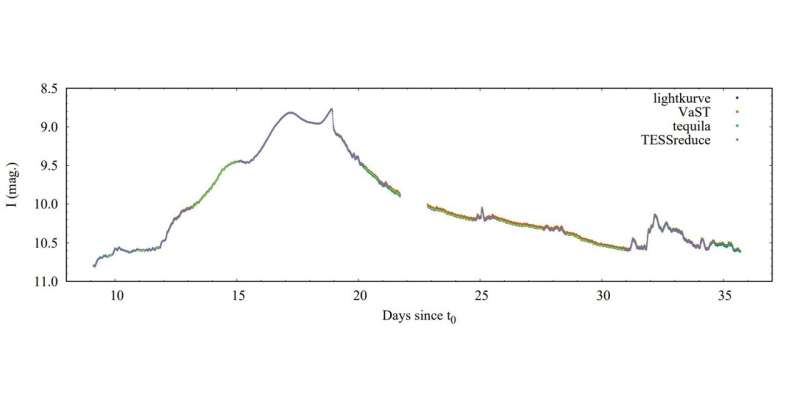November 16, 2023 report
This article has been reviewed according to Science X's editorial process and policies. Editors have highlighted the following attributes while ensuring the content's credibility:
fact-checked
preprint
trusted source
proofread
Peculiar nova eruption inspected by astronomers

An international team of astronomers has employed NASA's Transiting Exoplanet Survey Satellite (TESS) to observe the eruption of Nova Vulpeculae 2021. Results of the observational campaign, published November 8 on the pre-print server arXiv, provide important insights into the peculiar nature of this classical nova, unveiling its complex variability behavior.
A classical nova is a star experiencing a sudden increase in brightness and then slowly returning to its original state, a process that could last many months. Such an outburst is the result of the accretion process in a close binary system containing a white dwarf (WD) and its companion.
Typical classical novae exhibit a rapid rise of optical brightness until its peak, followed by a slow decline. However, some novae showcase more complex behavior than the standard "fast rise—smooth decline" pattern.
Nova Vulpeculae 2021 (or V606 Vul for short) is one of such eruptions that deviates from the traditional model. V606 Vul was detected on July 16, 2021, nine days before the start of TESS observations. A group of astronomers led by Kirill Sokolovsky of the University of Illinois at Urbana-Champaign, decided to investigate V606 Vul with TESS, hoping to shed more light on this nova.
"We use TESS photometry of the V606 Vul eruption to characterize variability of a nova in exquisite detail," the researchers wrote in the paper.
TESS observations covered the first of two primary peaks following the eruption of V606 Vul. This light curve showed that the nova had achieved its brightest visual magnitude during its second peak, which took place 64 days after the eruption.
By analyzing the light curve, the team found periodic variations, with a period of approximately 3.06 hours and a 0.01 mag average peak-to-peak amplitude, that are present except when the nova was within 1 mag of peak optical brightness. They also identified mini-flares, with peak-to-peak amplitudes of up to 0.5 mag. They appear at seemingly random times in a series of one or more and are separated by quiescent times of undisturbed periodic variations.
The observations show that the periodic variations disappeared when V606 Vul reached its peak optical brightness. The astronomers assume that these variations result from the azimuthal asymmetry of the photosphere encompassing the underlying binary system. However, they do not exclude other explanations, such as an azimuthal asymmetry in the temperature of the photosphere.
Summing up the results, the authors of the paper noted that their study marks the first use of TESS photometry in investigating nova eruptions. They also underlined how helpful could TESS be exploring the behavior of Galactic novae.
"First, thanks to its high photometric precision we can characterize brightness variations in a nova with the amplitudes so low that they cannot be detected from the ground. Second, the space platform's ability to conduct virtually uninterrupted observations over the duration of a month allow one to probe variability on a 12–24 h timescale that is difficult to access with ground-based observations interrupted by the diurnal cycle," they concluded.
More information: Kirill V. Sokolovsky et al, TESS photometry of the nova eruption in V606 Vul: asymmetric photosphere and multiple ejections?, arXiv (2023). DOI: 10.48550/arxiv.2311.04903
Journal information: arXiv
© 2023 Science X Network




















